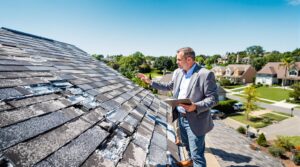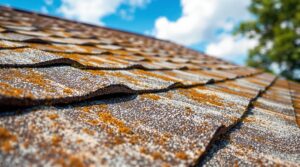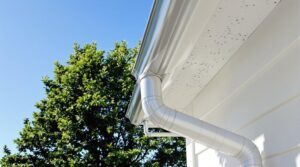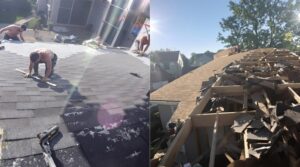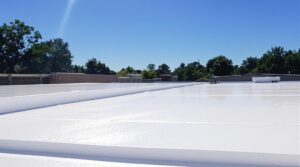Thinking about a partial roof replacement? Let's break down the costs without breaking your bank!
Just like ordering a half-pizza instead of the whole pie, replacing only the damaged section of your roof can be a smart financial move. The price tag typically swings between $2.50 and $30.00 per square foot – quite a range, right? That's because your final cost depends on everything from your zip code to your chosen roofing material.
Want to know where your money goes? Picture this: for every $100 you spend, about $60 goes straight to labor costs, with professional roofers earning $30-$130 per hour. Think of them as the skilled surgeons of your home's protective helmet!
When it comes to materials, you've got options. Budget-friendly asphalt shingles ($2.50-$5.50 per square foot) are like a reliable sedan – they'll get you through 15-20 years of weather protection. On the luxury end, copper roofing hits around $30.00 per square foot but stands guard for 60+ years – think of it as the Tesla of roofing materials.
Don't forget the behind-the-scenes players: permits, inspections, and insurance claims. These sneaky extras can impact your wallet, so it's worth doing your homework. Ready to give your roof the TLC it deserves while keeping costs in check?
Key Takeaways
Wondering What a Partial Roof Replacement Will Cost You? Let's Break it Down!
Think of your roof like a puzzle – sometimes you only need to replace a few pieces rather than the whole thing. Here's what you need to know about the investment:
The Core Numbers
Your wallet will feel a hit of $1.50-$3.00 per square foot for expert hands to do the job, while materials start at $2.50 per square foot. But hold on – that's just the beginning of the story!
Location, Location, Location
Just like real estate, where you live plays a huge role. Your local roofing scene affects everything from labor rates to those necessary-but-painful permit fees ($400-$1,500). Don't forget about those mandatory inspections that keep everything up to code!
Material Matters
Want to go basic or luxurious? Your choice of roofing materials is like picking between a Honda and a Ferrari:
- Budget-friendly asphalt shingles: $2.50-$5.50/sq ft
- Living-the-high-life copper: $30/sq ft
Smart Planning Tips
🔨 Set aside 10-20% extra for those "surprise" moments (trust us, old roofs love their secrets)
👷 Remember that skilled labor makes up about 60% of your costs
⏰ Professional roofers charge $30-$130 hourly, depending on their expertise level
Ready to give your roof the attention it deserves without breaking the bank? Plan smart, choose wisely, and your partial roof replacement can be a smooth sailing project!
Understanding Partial Roof Replacement
A partial roof replacement serves as a strategic solution when only specific sections of a roof require replacement rather than the entire structure. This targeted approach proves particularly effective for addressing localized damage caused by severe weather, fallen debris, or uneven aging patterns.
Regular roof maintenance and consistent inspection frequency help identify areas suitable for partial replacement before problems escalate.
This method strikes a practical balance between minor repairs and complete replacement, preserving the integrity of undamaged sections while addressing specific issues.
While cost-effective and less disruptive than full replacements, homeowners should consider potential challenges such as material matching and warranty limitations.
The approach particularly suits situations involving isolated damage, specific leak repairs, or preparations for solar panel installations, offering a pragmatic solution for maintaining roof functionality.
For homes with architectural complexity, partial replacements can increase costs by 25-50% compared to simpler roof sections.
Key Factors That Impact Replacement Costs
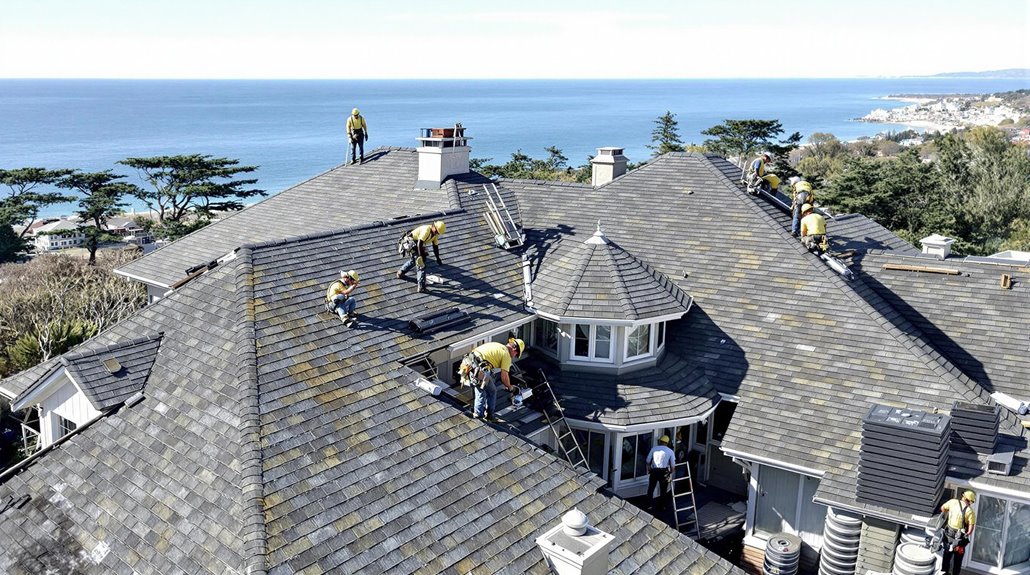
Several critical factors influence the cost of partial roof replacement, with size, complexity, labor requirements, and geographic location serving as primary determinants.
Roofing techniques vary based on roof design, with contractors calculating costs per roofing square (100 square feet). Complex structures featuring multiple valleys, dormers, or steep pitches require specialized labor and additional safety measures, considerably impacting the cost breakdown.
Labor typically comprises 60% of total expenses, ranging from $1.50 to $3.00 per square foot for basic asphalt shingle installations.
Regional variations affect pricing substantially, with coastal areas like California and New York commanding higher rates.
Additional cost considerations include permit fees, inspection requirements, removal of existing materials, and potential structural repairs.
Seasonal timing can also influence pricing, with fall and spring often offering more competitive rates.
Working with public adjusters can increase settlement amounts by 20-50% when filing insurance claims for partial roof replacements.
Material Options and Price Ranges

Material selection stands as the primary cost determinant in partial roof replacements, with options ranging from economical asphalt shingles at $2.50 per square foot to premium copper installations reaching $30.00 per square foot. Material durability varies greatly across options, with traditional asphalt shingles lasting 15-20 years while copper roofing can exceed 60 years of service life. Roofing aesthetics play an essential role in selection, particularly for visible sections requiring replacement. Public adjusters can help maximize insurance settlements for partial roof replacements, typically increasing payouts by over 500%. Common flat roof materials include PVC, EPDM, and TPO membranes, all ranging from $6-$15 per square foot, each offering distinct advantages in durability and weather resistance.
| Material Type | Cost/Sq Ft | Durability Rating |
|---|---|---|
| Asphalt | $2.50-$5.50 | Medium |
| Metal | $12-$20 | High |
| Synthetic Slate | $9-$12 | High |
| Copper | $15-$30 | Very High |
Labor Costs and Regional Variations
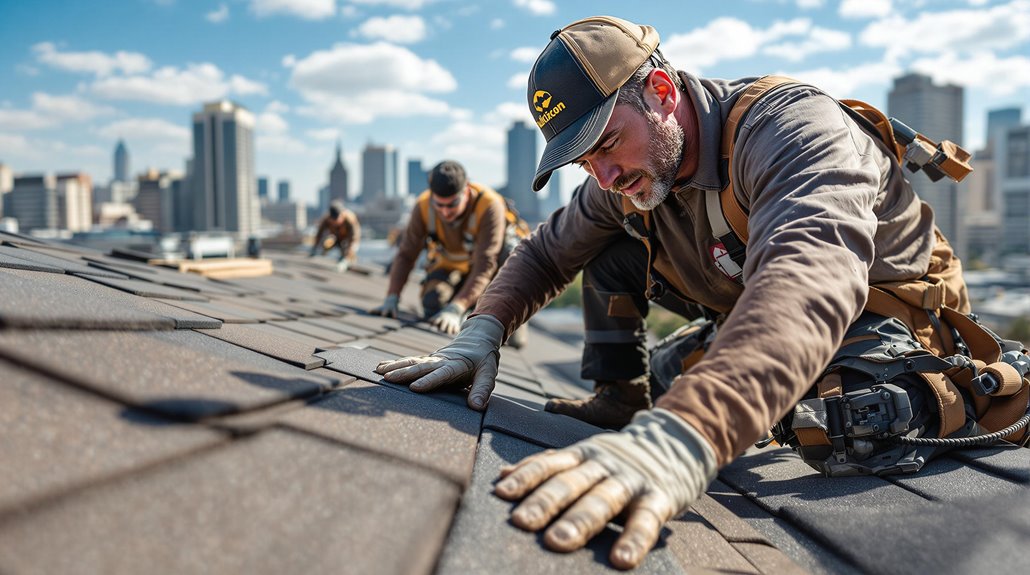
Labor costs constitute approximately 60% of total roof replacement expenses, with professional roofers commanding rates between $30 and $130 per hour depending on expertise level and regional market conditions.
Shingle installation labor typically ranges from $2.00 to $3.50 per square foot, while metal roofing installation costs between $4.00 and $8.00 per square foot.
Regional variations in the labor market greatly impact overall project costs.
- Massachusetts leads top-paying states with mean wages of $34.80 per hour
- Metropolitan areas like Worcester, MA-CT and San Jose, CA command premium rates
- Local building codes and permit requirements affect labor pricing
- Cost comparison across multiple contractors helps identify regional pricing trends
- Seasonal demand fluctuations influence labor costs, with potential savings during off-peak periods
Insurance coverage limits can significantly affect the amount available for labor costs during roof replacement projects.
Signs Your Roof Needs Partial Replacement
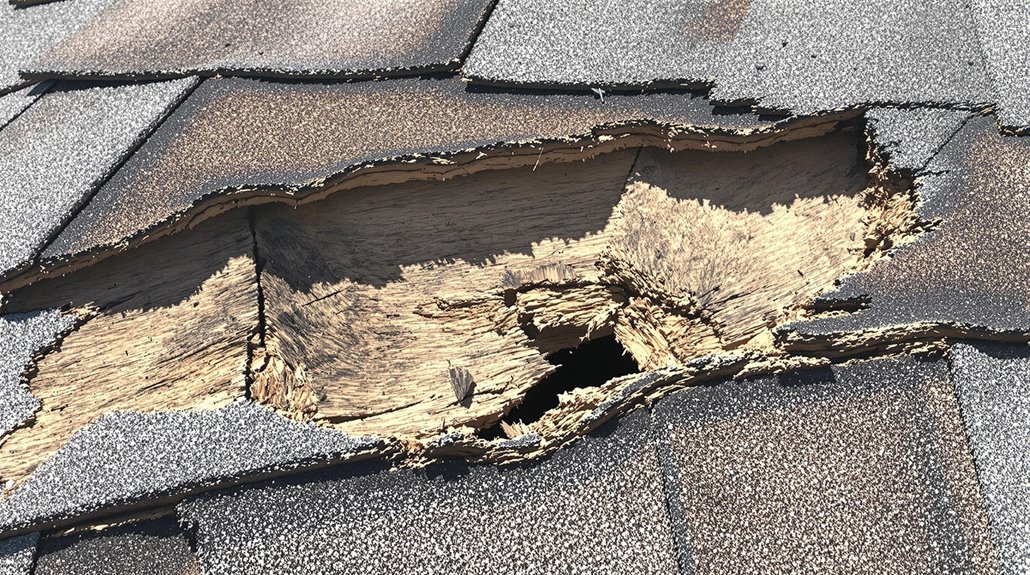
Visual indicators can reveal when partial roof replacement becomes necessary, including localized damage like missing shingles, cracks, or holes in specific sections.
While minor repairs may address isolated issues, significant deterioration confined to one area of the roof often requires partial replacement rather than simple repairs.
Professional evaluation of these warning signs helps determine whether partial replacement is appropriate, particularly when damage is concentrated in a specific zone while the remainder of the roof maintains structural integrity.
When damage affects less than 30% of the total roof surface, targeted partial replacement can be a cost-effective solution.
Visual Warning Signs
Identifying the warning signs of roof damage early can prevent extensive structural issues and costly repairs. Several visual indicators and interior signs can help homeowners determine if a partial roof replacement is necessary.
Visual inspection should focus on shingle condition, structural deformities, and moisture-related damage patterns.
- Missing, cracked, or curling shingles indicate weather-related deterioration
- Dark spots or bruising on shingles suggest hail damage and compromised protection
- Water stains on ceilings or walls reveal active leaks requiring attention
- Sagging roof sections or uneven surfaces point to structural weakness
- Moss growth and excessive granule loss signal ongoing degradation
Professional assessment is recommended when these warning signs appear, as they often indicate localized damage suitable for partial replacement rather than complete roof renovation.
Having thorough damage documentation with photographs and detailed notes is essential for successful insurance claims and accurate contractor estimates.
When Repairs Aren't Enough
While minor roof repairs can address temporary issues, certain indicators signal when more extensive intervention becomes necessary. When damage is localized to specific areas or confined to one section, partial replacement becomes a viable solution, provided the underlying structure maintains its integrity. Proper roof maintenance can help identify these signs early.
A thorough cost analysis should consider factors such as the age of existing materials, the extent of damage, and long-term financial implications. Multiple layers of roofing materials, extensive granule loss, or curled shingles typically indicate the need for replacement rather than repairs.
Professional contractors can assess whether partial replacement suffices or if full replacement is required, taking into account both structural concerns and potential warranty implications. The decision often balances immediate budget constraints against long-term durability requirements. Working with public adjusters on insurance claims can increase settlement payouts by 20-50% compared to filing independently.
The Assessment and Planning Process

Before undertaking a partial roof replacement, a thorough assessment and planning process must be initiated to confirm project success.
Professional inspection techniques identify damage extent, structural integrity, and material compatibility requirements. Expert contractors evaluate the feasibility while establishing budgeting strategies that account for materials, labor, and potential contingencies.
Key components of the assessment and planning phase include:
- Extensive damage evaluation of affected sections
- Documentation of inspection findings for accurate cost estimation
- Material selection to guarantee seamless integration with existing roof
- Development of detailed project scope and timeline
- Creation of budget with 10-20% contingency buffer
This systematic approach guarantees all critical factors are considered before commencing work, minimizing unexpected complications and ensuring ideal results for the partial replacement project.
Working with licensed adjusters can increase insurance claim settlements by 30-50% when damage assessment is required.
Comparing Costs: Partial vs. Full Replacement
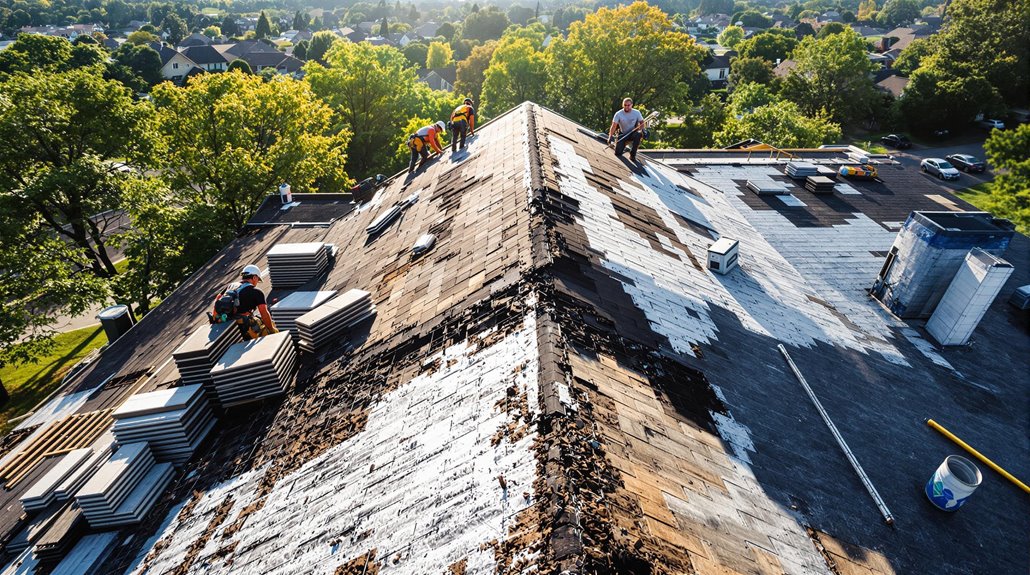
The cost differential between partial and full roof replacement represents a significant decision point for property owners. While partial replacements range from $150 to $7,000, full replacements typically cost between $6,700 and $80,000, with a median of $11,500.
A thorough cost benefit analysis must consider both immediate expenses and long-term implications.
Replacement timelines factor heavily into the decision-making process. Partial replacements offer immediate budget relief but may result in higher cumulative costs due to repeated repairs.
Materials and labor represent the primary cost drivers, with materials accounting for 40-50% of expenses and labor up to 60%.
Full replacements, while requiring larger upfront investment, often prove more economical over time through improved energy efficiency and reduced maintenance needs.
Insurance claims for roof damage typically result in 800% higher payouts when utilizing professional public adjuster services.
Permit Requirements and Additional Expenses
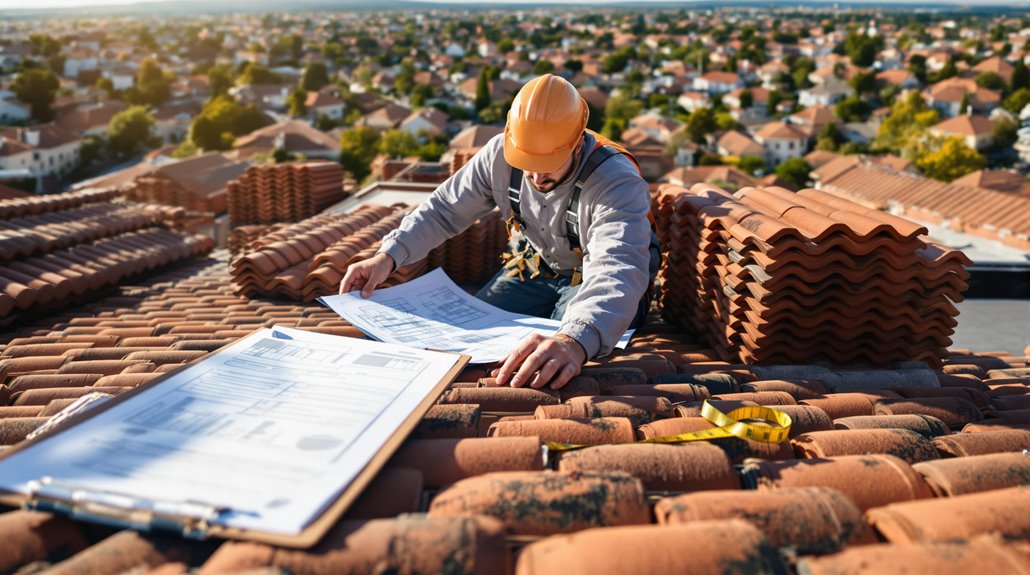
The permitting process for partial roof replacements in Lee County requires compliance with the Florida Building Code and submission of detailed project documentation, including Product Approval Numbers and roof plans.
Inspection costs encompass both initial permit review fees and subsequent site visits to verify code compliance, particularly for structures built before 1995 with values exceeding $300,000.
Local regulations may impose additional requirements, such as engineering approval for first-time tile installations and specific HOA permits, which can greatly impact the total project cost.
Building Permit Basics
Understanding permit requirements stands as an essential first step in any partial roof replacement project. Building permits vary based on specific project parameters, with some renewals exempt while others require formal approval. A thorough application checklist must address structural modifications, historical considerations, and weight limitations.
Key permit considerations include:
- Exemptions for basic roof covering renewals without structural alterations
- Mandatory permits for historical districts regardless of scope
- Weight restrictions requiring permits when materials exceed 6 pounds per square foot
- Surface area limitations of 25% for permit-free sheathing replacement
- Required structural reviews for complex modifications
Permit costs typically range from $400 to $1,500 for standard roof replacements, with additional fees possible for technology, plan reviews, and historic alterations.
Applications must include detailed project specifications, material types, and cost estimates.
Hidden Inspection Costs
Hidden costs associated with roof inspections encompass multiple layers of expenses beyond basic permit fees, including mandatory pre-inspection assessments, final compliance reviews, and potential remediation requirements. Inspection impacts can greatly affect project timelines and budgets, with fees ranging from $100 to $300 per inspection. Thermal imaging technology helps identify hidden moisture damage during comprehensive roof evaluations.
| Inspection Type | Cost Range | Compliance Challenges |
|---|---|---|
| Pre-Project | $100-$200 | Code verification required |
| Mid-Project | $150-$250 | Material standards check |
| Final Review | $200-$300 | Safety certification needed |
Non-compliance issues can result in considerable additional expenses, including fines and mandatory rework. Local building codes may require specialized materials or installation methods, particularly in areas with strict homeowner association oversight or specific climate considerations. Understanding these requirements helps prevent costly delays and guarantees proper project completion.
Local Code Requirements
While commencing partial roof replacement projects, property owners must navigate complex permit requirements that vary considerably by jurisdiction and scope of work.
Local regulations often mandate permits for structural modifications, with costs ranging from $10 to several hundred dollars depending on project size. Building inspectors review applications to guarantee compliance with established codes, requiring detailed documentation of materials and measurements.
- Permit fees typically range from $10-$50 for basic projects
- Structural changes require mandatory permit approval
- Building code compliance affects insurance claim validity
- The International Building Code (IBC) governs roof replacements
- Local regulations may restrict material choices in historic areas
The permit processes safeguard property owners from potential legal complications and guarantee adherence to safety standards.
Failure to obtain necessary permits can result in fines and insurance claim complications, making compliance essential for successful project completion.
Tips for Selecting a Qualified Contractor
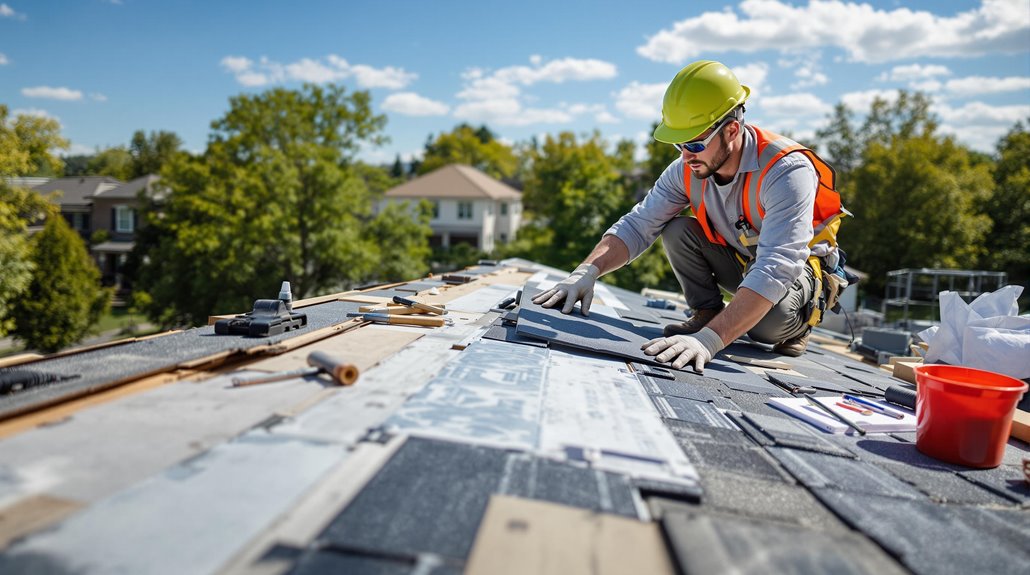
Selecting a qualified roofing contractor requires careful evaluation of credentials, experience, and professional reputation. Homeowners should verify contractor qualifications by confirming valid licenses, insurance coverage, and professional affiliations.
Additionally, reviewing the contractor's project portfolio, checking references, and investigating complaint history through the Better Business Bureau helps establish reliability.
When evaluating potential contractors, obtain detailed written proposals specifying materials, project timelines, and warranty information. Compare multiple estimates while considering factors beyond cost, such as workmanship quality and local experience.
Verify that contractors understand local building codes and have experience with similar roofing systems. Professional contractors should demonstrate clear communication, provide thorough documentation, and maintain transparent payment procedures throughout the project planning phase.
Maximizing Your Partial Roof Replacement Investment
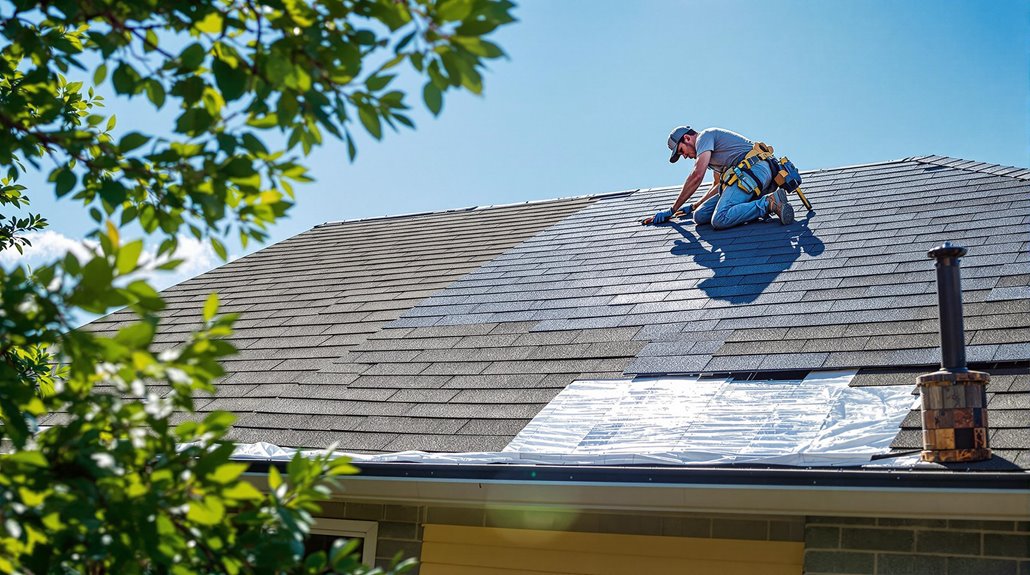
After securing a qualified contractor, homeowners can focus on optimizing their partial roof replacement investment through strategic planning and informed decision-making.
Understanding the ROI potential and implementing cost effective solutions can greatly impact the project's long-term value. Material longevity plays an essential role in maximizing returns, with high-quality materials typically delivering better performance and durability despite higher initial costs.
- Calculate potential ROI by multiplying installation costs by 68.4% to assess value addition
- Select materials that balance durability and cost, considering the existing roof structure
- Schedule regular inspections to identify and address issues before they escalate
- Factor in energy efficiency improvements to reduce long-term operational costs
- Monitor market trends to guarantee material choices align with local real estate values
The Benefits Of Consulting A Public Adjuster
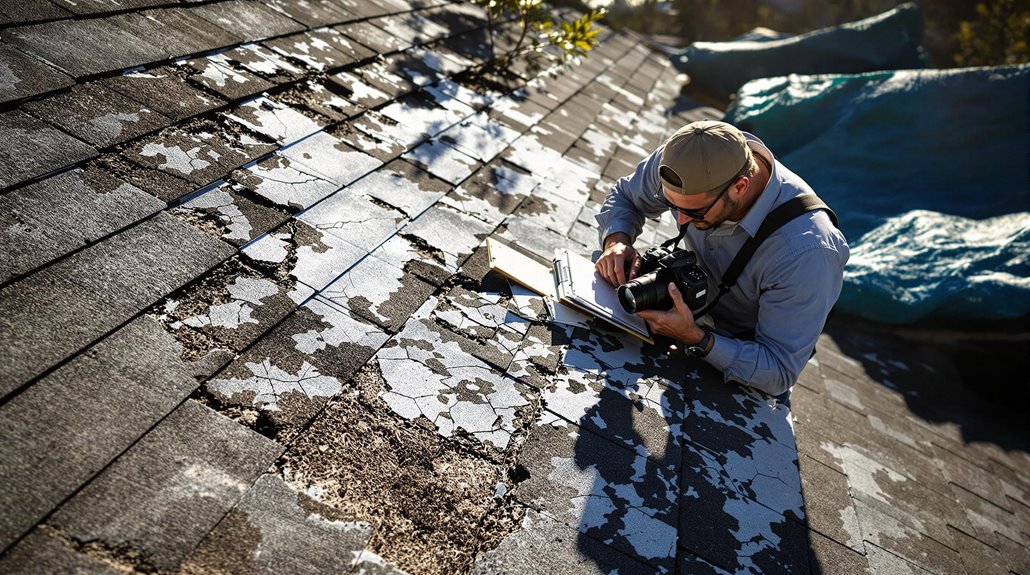
Public adjusters provide specialized expertise in managing complex insurance claims for partial roof replacements, conducting thorough assessments that often identify damages overlooked by insurance company adjusters.
Their objective evaluation process includes detailed documentation and photographs, strengthening the claim's validity while expediting the overall settlement timeline.
Studies consistently demonstrate that policyholders who engage public adjusters achieve higher claim settlements through expert negotiation and extensive policy understanding.
Expertise In Insurance Claims
When homeowners face the complex process of filing an insurance claim for partial roof replacement, consulting a public adjuster can provide invaluable expertise and professional guidance.
Through thorough policy understanding and proven insurance claim strategies, these professionals help navigate complex coverage terms while implementing claim denial prevention measures. Their expertise guarantees accurate documentation and maximizes settlement potential.
- Interprets complex policy language and identifies critical coverage elements
- Conducts extensive damage assessments and prepares detailed documentation
- Manages all communication with insurance carriers throughout the claim process
- Implements strategic negotiation techniques to secure fair settlements
- Provides professional representation during claim disputes or appeals
Public adjusters' in-depth knowledge of insurance procedures streamlines the claims process, reducing stress for homeowners while working to achieve ideal settlement outcomes.
Their expertise proves particularly valuable when dealing with partial roof replacement claims, which often require specialized documentation and negotiation skills.
Objective Damage Assessment
A thorough damage evaluation conducted by a public adjuster provides homeowners with an unbiased appraisal of their roof's condition and accurate documentation of all damages. The damage evaluation process employs systematic protocols to quantify losses and determine insurance implications.
| Evaluation Component | Analysis Method | Documentation Required |
|---|---|---|
| Physical Inspection | On-site analysis | Detailed photos/reports |
| Cost Estimation | Industry software | Itemized calculations |
| Causation Analysis | Weather data review | Historical records |
Public adjusters utilize specialized expertise to examine key indicators such as material degradation, structural integrity, and evidence of water infiltration. Their extensive approach includes reviewing local building codes, analyzing repair requirements, and evaluating collateral damage patterns. This methodical process guarantees accurate identification of all damages, leading to properly valued insurance claims and appropriate compensation for necessary repairs.
Streamlined Claim Process
The decision to consult a public adjuster offers four distinct benefits that streamline the roof damage claims process: thorough documentation management, significant time and stress reduction, expert policy interpretation, and skilled negotiation advocacy.
Public adjusters meticulously handle claims documentation while implementing proven negotiation strategies to secure fair settlements for partial roof replacements.
- Extensive photo and video documentation of roof damage
- Detailed written descriptions supporting visual evidence
- Professional interpretation of policy coverage and endorsements
- Strategic communication with insurance carriers
- Expert negotiation tactics to counter minimization attempts
This systematic approach guarantees policyholders receive maximum compensation while avoiding the complexities of managing claims independently.
Public adjusters' expertise in policy analysis and industry procedures enables them to identify additional coverages and navigate intricate claim requirements efficiently, ultimately expediting the settlement process.
Higher Claim Payouts & Settlements
Hiring a public adjuster greatly increases the likelihood of securing higher settlements for partial roof replacement claims. Public adjusters typically charge up to 10% of the settlement amount, working on a contingency basis that requires no upfront costs from homeowners.
Through thorough policy analysis and expert claim negotiation, these professionals leverage their specialized knowledge to maximize settlement values. They conduct detailed damage assessments, document all issues thoroughly, and compile necessary supporting evidence.
Their expertise in understanding coverage terms and exclusions enables them to identify opportunities for higher payouts that homeowners might otherwise miss.
Public adjusters serve as objective intermediaries, utilizing their experience to navigate complex insurance processes while ensuring compliance with state regulations. This professional representation often results in considerably larger settlements compared to homeowner-managed claims.
About The Public Claims Adjusters Network (PCAN)
Professional representation through the Public Claims Adjusters Network (PCAN) provides policyholders with state-licensed insurance experts who specialize in managing and negotiating insurance claims.
These independent professionals deliver thorough support throughout the claims process, from initial documentation to final settlement negotiations, guaranteeing ideal outcomes for policyholders.
Key Public Adjuster Benefits include:
- Expert policy interpretation and coverage assessment
- Detailed damage inspection and documentation
- Professional loss estimation and valuation
- Strategic negotiation with insurance companies
- Time-efficient claim management and processing
PCAN adjusters possess specialized training and maintain extensive professional networks, enabling them to address complex claims effectively.
Their independent status guarantees unbiased representation, while their expertise in policy interpretation and damage assessment helps maximize settlement amounts for policyholders experiencing partial roof damage.
Frequently Asked Questions
Will My Homeowner's Insurance Cover Partial Roof Replacement?
Insurance policies typically cover partial roof replacement, depending on coverage limits, cause of damage, roof age, and maintenance history. Pre-existing conditions and normal wear are generally excluded from coverage.
How Long Does a Typical Partial Roof Replacement Take to Complete?
A partial roof replacement typically takes 1-3 days, with timeline factors including size, material type, weather conditions, and workforce size. Project efficiency depends on complexity and team experience.
Can I Stay in My Home During a Partial Roof Replacement?
While deafening noise levels and safety concerns exist, homeowners can typically remain in their residence during partial roof replacement, provided they follow contractor guidelines and maintain restricted zones.
What Happens if It Rains During My Partial Roof Replacement?
Rain during partial roof replacement requires immediate work stoppage. Contractors implement rain protection measures using tarps and temporary barriers. Exposed areas must be secured to maintain roof safety and prevent water damage.
Should I Replace Nearby Gutters When Doing a Partial Roof Replacement?
Gutter replacement during partial roof work depends on their condition. Replacing damaged gutters guarantees proper gutter alignment and drainage efficiency, while functional gutters can remain if they integrate well with new roofing.
References
- https://modernize.com/roof/cost-calculator
- https://newenglandcondo.com/article/roof-replacement-101
- https://www.bobvila.com/articles/roof-replacement-cost/
- https://www.roof-crafters.com/learn/full-roof-replacement-vs-roof-repair
- https://roofingcalculator.com
- https://grs-roofing.com/partial-roof-replacement-is-it-an-option/
- https://goldkeyroofing.com/a-detailed-guide-to-examining-the-costs-of-replacing-your-roof/
- https://govolpe.com/all-you-need-to-know-about-partial-roofs/
- https://jdhremodeling.com/essential-guide-to-roofing-replacement-costs-and-considerations/
- https://bidlist.io/public/partial-roof-replacement-an-in-depth-guide/
